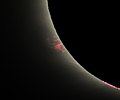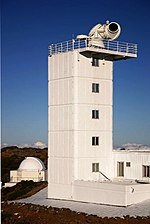In solar physics, a spicule, also known as a fibril or mottle, is a dynamic jet of plasma in the Sun's chromosphere about 300 km in diameter. They move...
4 KB (480 words) - 11:23, 5 January 2024
found in male nematodes (roundworms) Spicule (solar physics), jets of solar material from the Sun Spicule (glass manufacture), glass flakes formed in the...
770 bytes (130 words) - 15:21, 28 May 2018
interface for coronal heating. Solar cycle Solar spicule Solar granule Athay, R. Grant; Warwick, Constance S. (1961). "Indices of Solar Activity". In Landsberg...
4 KB (389 words) - 05:29, 16 July 2024
Coronal hole Solar spicule "The Transition Region". Solar Physics, NASA Marshall Space Flight Center. NASA. Mariska, John (1993). The Solar Transition Region...
4 KB (512 words) - 22:37, 7 April 2024
Coronal loop (redirect from Solar coronal loop)
are sensitive to the radiation emitted by quiescent coronal loops. Solar spicule Solar prominence Coronal hole Loff, Sarah (2015-04-17). "Coronal Loops...
13 KB (1,691 words) - 16:17, 9 September 2024
the surface of the sun, including solar spicules, coronal loops, and some coronal mass ejections, was considered a solar prominence. Today, due to a better...
17 KB (1,885 words) - 08:42, 22 June 2024
Sun (redirect from Solar diameter)
The Sun is the star at the center of the Solar System. It is a massive, nearly perfect sphere of hot plasma, heated to incandescence by nuclear fusion...
167 KB (18,910 words) - 23:13, 12 October 2024
Heliosphere (section Solar wind)
"inflated" by plasma originating from the Sun, known as the solar wind. Outside the heliosphere, this solar plasma gives way to the interstellar plasma permeating...
63 KB (6,605 words) - 05:02, 4 October 2024
Stellar corona (redirect from Solar corona)
Martin's Solar and Astrophysics Laboratory (LMSAL) and the Institute of Theoretical Astrophysics of the University of Oslo, a new class of spicules (TYPE...
62 KB (7,677 words) - 00:54, 25 September 2024
Chromosphere (section Spicules)
activity. The most commonly identified feature in the solar chromosphere are spicules. Spicules rise to the top of the chromosphere and then sink back...
12 KB (1,331 words) - 21:45, 11 October 2024
Furthermore, some solar jets are classified as macrospicules due to their similarities with the much smaller chromospheric spicules. Solar jets are sometimes...
5 KB (540 words) - 13:46, 17 May 2024
the center to about 0.2 of the solar radius (139,000 km; 86,000 mi). It is the hottest part of the Sun and of the Solar System. It has a density of 150...
14 KB (1,894 words) - 21:58, 8 September 2024
part of the Sun, and not artifacts of the eclipse. He discovered solar spicules. However, his main area of interest was astronomical spectroscopy. He invented...
14 KB (1,494 words) - 09:12, 13 September 2024
Moreton wave (redirect from Solar tsunami)
band. Asteroseismology Gravity wave Helioseismology OSO 8 Solar prominence Solar spicule Solar transition region Phillips, Tony (November 24, 2009). "Monster...
6 KB (562 words) - 19:02, 13 August 2023
Outline of astronomy (section Solar System)
Plage Spicule Moreton wave Solar corona Solar transition region Coronal hole Coronal loop Coronal mass ejection Solar prominence Helmet streamer Solar variation...
43 KB (3,397 words) - 22:38, 4 October 2024
Solar Physics Information on the SST at the Institute for Solar Physics wiki SST APOD pictures of a sunspot, the Venus transit, spicules on the solar...
10 KB (1,117 words) - 15:55, 7 March 2024
authoritatively that the sun is a star; discovered the existence of solar spicules and drew an early map of Mars Alessandro Serpieri (1823–1885) – priest...
57 KB (7,301 words) - 05:45, 9 September 2024
atmosphere, just above the photosphere, is the thin chromosphere region, where spicules appear and stellar flares begin. Above this is the transition region, where...
147 KB (16,412 words) - 12:11, 7 September 2024
50,000 km-long spicules may also play a part in accelerating the solar wind past the corona. Alfvén waves are routinely observed in solar wind, in particular...
38 KB (4,652 words) - 13:59, 8 September 2024
their skeletons out of silica, which forms a unique lattice structure of spicules. The sponges are usually between 10 cm (3.9 in) and 30 cm (12 in) tall...
16 KB (1,768 words) - 04:05, 19 September 2024
sequence stars below about 0.3 solar masses are entirely convective, meaning they do not have a radiative zone. From 0.3 to 1.2 solar masses, the region around...
11 KB (1,764 words) - 22:13, 8 September 2024
is a forest of spicules poking out from the edge, so it is not possible to get parallel to such a rough surface. For most of the solar disk the degree...
4 KB (495 words) - 14:33, 8 November 2020
of which is visible in the Sun as solar granulation. Low-mass main-sequence stars, such as red dwarfs below 0.35 solar masses, as well as pre-main sequence...
7 KB (837 words) - 22:35, 8 September 2024
archenteron. Although there are numerous molecular differences between the "spicule-forming cells" of E. tribuloides and the primary mesencyhme cells of euechinoids...
12 KB (1,262 words) - 19:31, 1 October 2024
laid down c. 650 Ma – First Demosponges appear: form first skeletons of spicules made from protein spongin and silica – brightly coloured these colonial...
64 KB (7,673 words) - 07:50, 6 October 2024
and ice spikes. iceberg ice accretion indicator ice crystal 1. A minute spicule of ice that forms from water in the atmosphere at temperatures below the...
187 KB (21,500 words) - 23:23, 1 June 2024
ear of grain spica, spicate, spicose, spicosity, spicular, spiculate, spicule, spiculiform †spiculum spicul- spina spin- thorn infraspinate, infraspinatus...
317 KB (336 words) - 13:29, 14 September 2024
spike Latin spica spica, spicate, spicose, spicosity, spicular, spiculate, spicule, spiculiform spin- thorn Latin spina infraspinate, infraspinatus, interspinal...
2 KB (1,764 words) - 06:15, 16 April 2024
glycoproteins. This may be calcified to form structures like shells, bones, and spicules, a framework upon which cells can move about and be reorganized during...
90 KB (9,629 words) - 04:08, 16 September 2024
Evershed effect (category Solar phenomena)
different cross-sections of the coronal loops footpoints, the return of spicules, multiple flows, nanoflares, and thermal instabilities during chromospheric...
6 KB (592 words) - 07:54, 16 November 2023





















